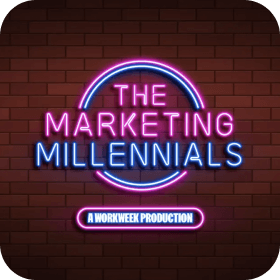I am stoked for you to meet today’s guest, Nancy Harhut.
Nancy is a legend in the space.
The Co-Founder and Chief Creative Officer at HBT Marketing, Nancy is bringing in a new wave of Marketing, applying human behavior techniques and psychology to some of the biggest brands in the world.
I was lucky enough to have her join The Marketing Millennials Podcast, let’s see what behavioral science GEMS she dropped (in her own liiiightly edited words).
1. Behavioral science is:
“In Marketing we think people make well thought out decisions, but very often people are affected by things they’re not aware of.
Up to 95% of purchase decision-making takes place in the subconscious mind (WHAT).
Marketers think they need to get the right message to the right person at the right time, if they do that, they’re golden. The truth is that only gets you part of the way.
That’s why marketers need to understand behavioral science. Not only do you need to get the right message to the right person at the right time, you need to do it in the right way.
The right way is in reference to a brain friendly way. A way that will make it more likely that people will notice, understand, and act on the message. Those are the things that have to happen in order for you to get an ROI for your Marketing.
(If we as marketers are aware of what influences human behavior, we’re more likely to get the behavior we’re looking for.)
2. The principle of reciprocity:
There’s a behavioral science principle called the reciprocity principle.
What behavioral scientists have found is when someone does something for you, you feel indebted.
The idea of the reciprocity principle is we like to return what someone has done for us. We don’t like to feel like we owe someone.
There was this particular group of financial advisors that stopped working with my client.
My client was trying to re-engage with them, they’d call, email, anything they could, but nothing was happening.
This went on for a year. What was our strategy to reel them back in?
Level up your marketing game
Zero BS. Just fun, unfiltered, industry insights with the game-changers behind some of the coolest companies from around the globe.
No spam. Unsubscribe any time.
To send them a gift (BOLD).
Yes, we sent something to the people who aren’t doing business with us and have been a dead-end for a year.
Why did we do this? The reciprocity principle. We sent out an email and said, watch your mailbox, there’s a gift on its way to you, something we’ve picked out especially for you.
The gift was something related to the financial advisors industry. And there was a short note attached from my client that said, we’ve been trying to get in touch with you and would really like to talk to you, please give us a call.
As a result, my client was able to reactivate a number of these financial advisors who had stopped working with them and traced back $68M in incremental revenue to this particular campaign.
A great example of the reciprocity principle in effect.
3. The endowment effect:
The Endowment Effect is the idea that we value things that we own.
If there’s something that we want to buy, obviously we value it because we want to acquire it.
But once that something becomes ours, we place even more value on it.
A great marketing example is this online wine company sent me an email wanting me to buy a bottle of wine by 11:59 tomorrow. They didn’t just say, buy a bottle of wine by 11:59 tomorrow.
(They had me at wine, not going to lie LOL.)
They said, you have $15 of unused credit in your account, which expires at 11:59 tomorrow.
They could have said, buy a bottle by 11:59 tomorrow and we’ll take $15 off the price, or send you a $15 rebate. It was the $15 already in my account that was so powerful.
I was already possessing the money and if I didn’t use it, I was going to lose it.
In the scheme of things it was the same offer but I was more inclined to buy because I thought of the $15 as being mine.
When you’re dealing with customer acquisition, describe things in a rich way, that people begin to imagine what it’s like to own or use them.
This will make them feel as if they have some ownership already. Then hammer home the idea of not purchasing the product, not following through with the purchase and customers will be afraid to lose it and ultimately add to cart.
4. This is 2x as painful:
People are twice as motivated to avoid the pain of loss as they are to achieve the pleasure of gain.
In marketing we’re all about the gains, benefits, and wonderful things that you’ll get if you just buy.
We absolutely want benefits, we know they work, but a little well-placed loss aversion can go a long way (ouuu ok, I hear you).
Instead of saying, “take advantage of this offer” say, “don’t miss this offer”. Instead of saying “buy today and you can save”, say “if you wait until tomorrow, you’re going to pay more”.
It’s a framing technique. We like to avoid mistakes, we don’t want to lose out.
5. Social proof, but done right:
People aren’t certain of what to do, they look around, they see what other people are doing, and they follow their lead (SOCIAL PROOOOOOF).
This is particularly true if the people we’re observing are similar to ourselves.
If you’re an entrepreneur, you look around and see what other entrepreneurs are doing, the products they’re using, and services they are subscribing to.
You look to see what people like you are doing and you follow their lead. It makes you feel like you’re not going to make a mistake (loss aversion again lol).
And it also makes you feel like you might miss out if you don’t do what your peers are doing. If everyone else is doing one thing, we assume they know something we don’t.
As marketers we can trigger this social proof in a number of different ways.
Testimonials are a fantastic way to do so. There are two things that will take a good testimonial and make it a great one.
The first is you want to make sure that the testimonial is as similar to the testimonial receiver as possible. If you’re talking to young mothers, get a quote from a young mother. If you’re talking to CFOs, get a quote from a CFO.
The second thing is starting at a place of skepticism, which is typically where the reader is going to be.
Is it as good as the marketer says it is? Is it worth my time and effort to find out if it’s worth the price? Is it any better than my current solution?
These are all the things that are going through someone’s head. A testimonial that says “I used to think that all *insert product here* were the same, but one day I tried this new brand and what a difference. Now I would never use another one” would be incredibly effective.
When someone reads that, they’re like yeah I feel that same way.
But that person in the testimonial was in the same boat as me and now they think it’s a superior product, maybe I should use it too.”


